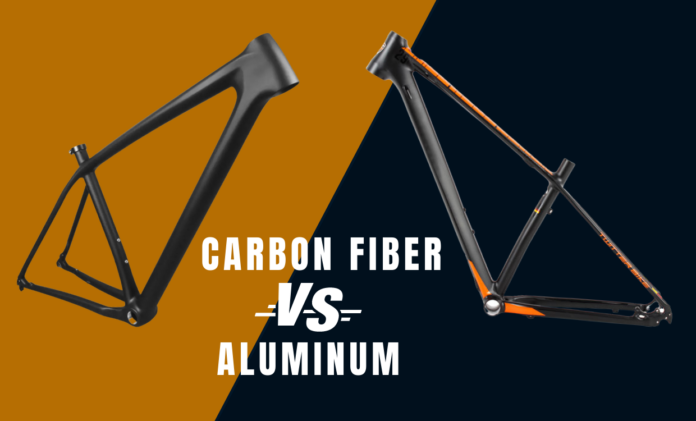In the world of mountain bikes, the carbon fiber vs. aluminum contest is a bit tough to decide. When carbon made its first appearance in the domain of mountain bikes during the 90s, its pros and cons were hotly debated.
Though many thought that carbon bikes would break and fail to sustain, they have been eventually proved wrong.
From the struggle of those initial days to craft a lightweight carbon frame to the present times when the focus has shifted to creating the best possible “carbon frame”, we have come a long way.
As a result, you’ll now find durable carbon frames that are capable of withstanding pretty tough and punishing conditions, which has helped them earn the “vote of confidence” of the pros.
However, too much rigidity is often a complaint leveled against carbon frames. If you’re a price-conscious buyer, aluminum mountain bikes would probably appeal more to you, thanks to their comparatively lower costs.
So, which among aluminum and carbon fiber is a good choice and offers more value for your money? Let’s dive right in to check a few things and find the answer ourselves.
Carbon Fiber vs. Aluminum: Side-By-Side Comparison

1. Heaviness
If you’re a competitive rider, having a lightweight mountain bike that lets you literally fly would be of utmost importance. But even if you don’t compete at the pro level, having a lighter bike would mean enjoying an easier climb, accelerating at will, and even maneuvering it just the way you would like to.
Wondering what that means? Well, an improved overall riding experience!
Though very light bikes can be crafted of either carbon or aluminum, carbon has a definite edge here. That’s because when you consider strength to weight ratio, carbon fiber has very few competitors and aluminum isn’t among them.
So, a frame made of carbon fiber will always weigh lighter than its aluminum equivalent.
As a result, carbon fiber wins this round of the carbon fiber vs. aluminum match.
Before you go out with all guns blazing to buy a carbon fiber frame, you need to remember certain things to make an informed choice. To begin with, not all carbon is created equal. If you invest in a lower-grade carbon frame, you would find it weighing more than a high-end aluminum frame.
Though carbon is the best choice for the lightest frames, cutting costs could make you end up with a frame that’s not ideal. Before you invest in a carbon fiber frame, ask yourself if you really need it.
Making the most of these frames isn’t the job of an average user. Since not many users are likely to splurge to get a superbike, entry- to mid-level bikes are where the focus mostly is.
For these categories, the difference of a pound or two won’t matter much. And rather than spending a fortune on carbon frames, losing a few extra kilos around your own midriff would help you enjoy better performance, minus the steep price tag. Sweet, isn’t it?
Don’t get me wrong. I’m not deterring you from buying a carbon fiber frame. What I’m trying to say is unless you’re a competitive racer with an extremely fit body, you are unlikely to extract the complete benefits of ultra-light carbon.
Verdict: Carbon definitely has an edge over aluminum weight-wise. But unlike pro users for whom shaving a few pounds off their MTB matters a lot, the average user won’t notice much of a difference, no matter what bike material they choose.
2. Longevity
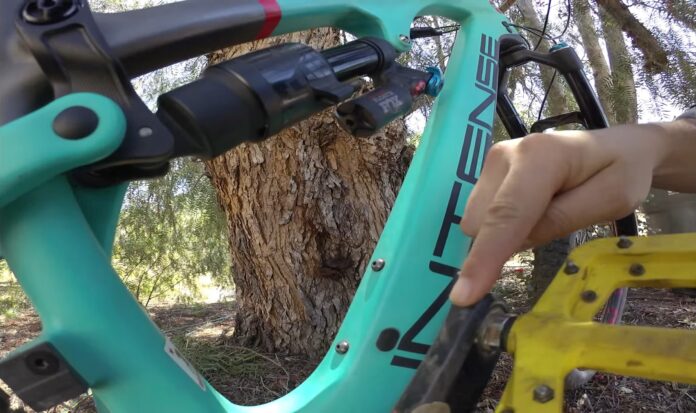
Carbon fiber frames are fragile – this is how most people view the material and they can’t be blamed. Search online and you’ll find lots of images of broken or damaged frames. But does that mean carbon fiber frames break easily?
The answer is, no, they don’t. It’s often a fault in the engineering of the damaged bike rather than the choice of the material.
Aluminum is often lauded for its stiffness but it makes it susceptible to stress fracturing. Thus, for each impact, aluminum will simply eat it up while carbon’s dampening effect will help it soak the impact and sort of rebound to its original place.
After your bike has traveled a thousand miles, the impacts that aluminum has been bearing will start appearing as microscopic cracks, which will turn into stress fractures with time, usually at the weakest points.
This, in turn, would reduce the frame’s strength and stiffness, ultimately triggering a failure. Thanks to its superior tolerance to frame bending, carbon is better at surviving high-impact incidences that would make an aluminum frame break.
Owing to its flex qualities, a carbon bike’s failure level/chances are much higher than its aluminum counterpart.
How these two materials get damaged is also important to know about. While aluminum will dent at first, then bend, and finally break, carbon will crack at first and then break.
This means with aluminum, you’ll notice the warning signs while it would be somewhat sudden with carbon (especially, if you don’t inspect your bike carefully and regularly) and even without a warning.
Verdict: Carbon has a much longer life span than aluminum. Theoretically, it can continue serving you for a lifetime with proper care. But in real life, crashes and sudden impacts, especially from unanticipated directions, can make it rupture. But that doesn’t mean carbon frames are more fragile than aluminum. They’re indeed stronger and capable of withstanding a considerable amount of force, provided it’s applied in the direction the manufacturers intended (like road shock from a pothole but not crashing into a tree).
3. The Comfort Quotient
This is another key aspect that you need to weigh in when comparing carbon fiber vs. aluminum MTBs. If you still believe aluminum frames to be extremely stiff, you’re living in a bygone era.
Agreed that it was true, but 20 years ago or so! Today, thanks to advanced frame creation technology, better investments, and superior knowledge, the gap between carbon and aluminum have been bridged to a great extent.
Using hydroforming, aluminum tubing’s shape can now be varied throughout its length. Thus, you’ll not only get laterally rigid rides but even vertically-compliant ones at the same.
Even aluminum’s thickness can be varied by making it extremely thin (think similar to a soda can!) where you need to meet compliance issues or keeping it thicker for rides where the focus is on strength and stiffness.
This has made contemporary aluminum frames in MTBs quite comfortable that can give their carbon counterparts a tough fight. But carbon still has a slight edge over aluminum.
If you use materials weighing the same, you’ll get 2 to 5 times more rigidity with quality carbon than steel and aluminum. Wondering how to decode this?
Well, if you’re a cross-country racer, your MTB’s stiffness and lightweight will matter a lot. With carbon fiber, you’ll be ready to enjoy an ultra-responsive, razor-sharp ride.
However, not all competitive riders would prefer stiffer rides. For example, if you’re a downhill or enduro-style trail rider, you’re likely to prefer a bit more flexibility and forgiveness.
So, choosing carbon alloy frames would be a good choice as it would suit your riding style and requirements much better than carbon fiber.
But when comfort is your prime concern, you need to check other factors such as bike geometry, tire clearance, fit, etc. that are more crucial than the material used to build the MTB frame.
And finally, remember that comfort isn’t something that always comes packaged. In most cases, you’ll have room to improve or fine-tune your MTB’s comfort level.
Verdict: Comfort-wise, carbon is a bit better than aluminum but thanks to modern technology, aluminum isn’t miles behind. You should remember that comfort isn’t determined alone by the frame material since other equally important factors too need to be considered.
4. The Price Tag
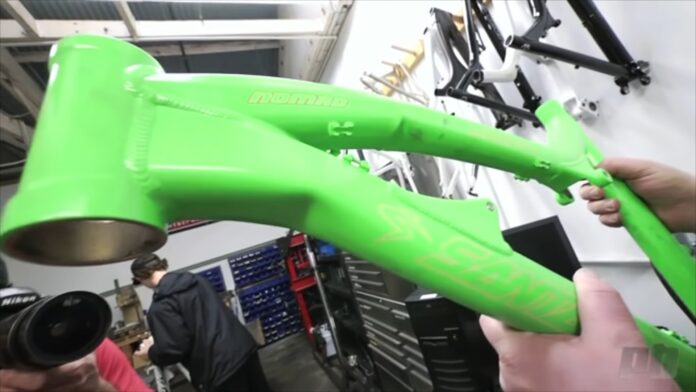
Though carbon fiber has become a lot more affordable today, it’s still a pricier option compared to aluminum. And the price difference isn’t just about the frame.
The quality of material used and the quantity matter too. Thus, when you’re considering buying a carbon fiber MTB, different parts of the bike like wheels, bars, brake levers, cranks, brake pads, stem caps, etc. are likely to use carbon fiber.
However, which bike parts use it would vary from one manufacturer to the other, and it would play a significant role in the final price you’ll have to shell out.
You already know that carbon fiber bike frames are costlier than their aluminum counterparts. But perhaps you don’t know that bike parts made of carbon fiber too can be extremely pricey.
For example, carbon wheels cost almost 7 times more than their alloy counterparts. Apart from the steep price of the material itself, the process that involves drilling, heat pressing, demolding, deflashing, finishing, etc. would also make the cost to escalate.
After all, the long hours it takes to get a carbon rim handcrafted is much more than the few minutes you need to shape and weld an aluminum rim.
As a result, the labor-intensive carbon rim would certainly cost more than an aluminum rim. Usually, a lot of manual work is involved when building the carbon parts for your MTB, which makes carbon fiber bikes much more expensive than what an aluminum MTB would cost.
Verdict: If cost is your key concern, aluminum wins this round of the carbon fiber vs. aluminum MTB match hands down.
5. The Appearance
When bikes were made of titanium and steel, no one would have imagined the appealing looks of modern MTBs possible. Yet, you have reasons to rejoice because MTBs today look pretty good with their smooth curves and alluring shapes.
And if you thought it’s only carbon that delivers these, think again because aluminum bike manufacturers today create bikes that look quite similar to their carbon counterparts.
By taking advantage of hydroforming, aluminum frames can now be molded into beautiful aerodynamic shapes while seamless welds give them a smooth look.
As a result, when watching them from a distance, you’ll find it pretty difficult to distinguish modern aluminum MTB frames from those made up of carbon.
However, “Looks” or “Beauty” is indeed a relative term because what looks good to you may be quite different from what your friend or your neighbor considers beautiful.
For instance, some riders prefer clean and even welds as they stand testimony to outstanding craftsmanship and give their bike a utilitarian look.
For some others, thick welds are the preferred choice as they give a “macho” look to their bike and make it ready to take the pounding of tough and punishing trails.
A few mountain bikers could even consider the look of either raw carbon or raw aluminum to be alluring.
Looks are sometimes equivalent to what you consider as a status symbol. Carbon is an “up-market” choice for many while aluminum is considered “lowly”. But the bottom line is a good-looking MTB can be built made of anything today, thanks to the modern technology and expertise of the professionals involved.
Verdict: None is a clear winner in this round. Whether you choose carbon fiber or aluminum, it’s completely you personal choice because what really matters is for you to feel happy and proud while riding your chosen bike.
6. The Feel
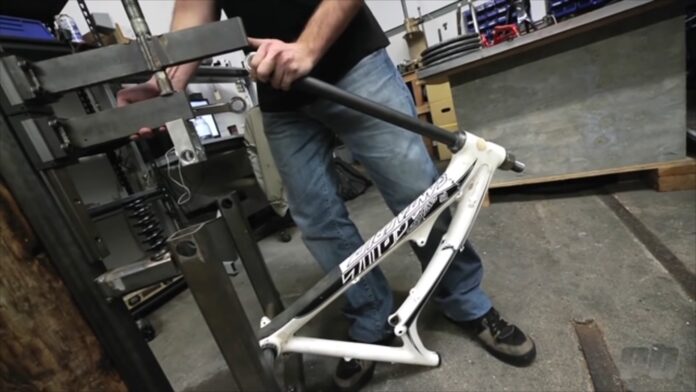
Carbon gives you a superior feel owing to two key factors – dampening and torsional stiffness. Being a stiffer material, aluminum transfers much more harshness of the trail (roots, rocks, etc.) into your hands and the buttocks.
Thanks to its dampening effect, which though minimal, carbon can still soak up some of the trail chatter to offer some respite to your hands and buttocks.
This can especially be welcome when you ride your MTB for long hours. Even if you don’t have a carbon frame, you can still enjoy carbon’s dampening effect to some extent by using a carbon Seatpost and carbon handlebars that soften the ride while taking a few pounds off your bike to make it feel lighter.
With a properly built carbon frame, the torsional stiffness will transfer all the pedal power into your rear wheel.
Although both aluminum and carbon frames flex somewhat, the latter tend to be torsionally stiffer. This prevents your bottom bracket from twisting with respect to the down tube and chainstay, thus letting you enjoy a snappier ride.
It’s due to this torsional stiffness and lighter weight that a carbon bike makes accelerating feel much faster, which would affect your performance and even give your confidence a big boost.
Verdict: With a carbon MTB, you’ll get a superior feel, which would make investing in it worth your money.
FAQ’s
Is Carbon Fiber More Durable Than Aluminum?
“Raw carbon” yarns are very brittle and lightweight, which need to be converted into high-strength carbon composites (with unparalleled strength-to-weight ratio) that are used by MTB manufacturers. The yarns are either woven or positioned parallelly (in a unidirectional manner), after which they’re squeezed between rollers to make the fibers saturated with catalyzed epoxy resins.
On paper, carbon fiber is tougher and more durable than aluminum but real-life instances often prove otherwise. However, such failures have more to do with the engineering process rather than the material itself.
Which Is stronger – Carbon or Aluminum?

What Is The Lifespan of a Carbon Bike Frame?
How Do I Know If My Bike Is Carbon or Aluminum?
Are Carbon Bikes Faster Than Aluminum?
How Long Do Aluminum Bike Frames Last?
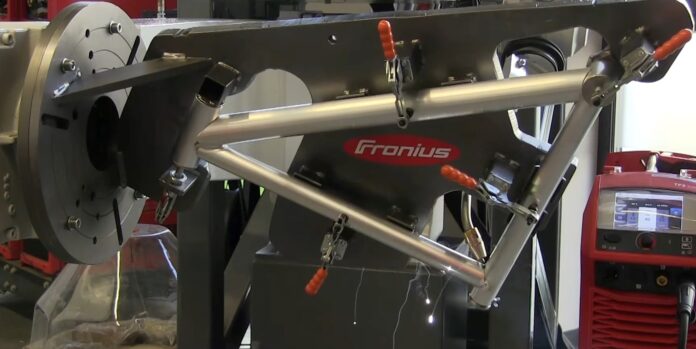
Conclusion
Carbon fiber seems to have an edge over aluminum but with modern technology, aluminum isn’t far behind. It all finally boils down to what you’re comfortable with. Unless you’re a pro competing at the highest levels, you’re unlikely to notice much of a difference between carbon fiber and aluminum MTB.
So, when taking your pick in this carbon fiber vs. aluminum contest, the power to decide rests in your hands.
